New World, New Horizons: Sophia of Hanover and Elite Female Self-Representation
Joey Koo
Advisors: Dr. Jeffrey Chipps Smith and Dr. Ann Johns

Abstract
In the 1640s, Sophia of Hanover commissioned a series of portraits depicting herself in the guise of an Indigenous American persona, set against a backdrop evocative of the “New World.” In these artworks, Sophia is portrayed alone within a tropical landscape, adorned with an Indigenous feather cloak, headpiece, and spear. This thesis examines these portraits through three key lenses. Firstly, it reviews the existing historiography of these images, aiming to reconcile discrepancies within the scholarship and establish a cohesive historiographic record. Secondly, this thesis contextualizes these portraits by looking at Sophia’s social milieu and examining her family’s extensive patronage, situating her artworks within broader social trends such as court mythology, artistic precedents, and the theatrical displays prominent among the Anglo–Dutch nobility. Finally, it explores the Transatlantic and colonial influences inherent to these portraits by linking Sophia’s pictures to early modern exploration narratives and the art from the Dutch Colony of Brazil. This paper examines these colonial concerns by utilizing contemporary theoretical frameworks used in post-colonial studies and by analyzing the Transatlantic social networks associated with Sophia and her family. These three lines of inquiry work to describe the complexity and nuance necessary to understand these artworks fully. The primary focus of this thesis is to interpret these images from the perspective of the patron, Sophia of Hanover, with particular emphasis on her motivations behind commissioning such artworks. Special attention is placed on her marital prospects and political ambitions.